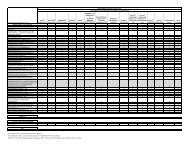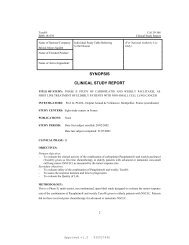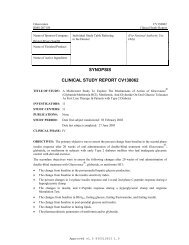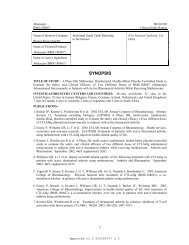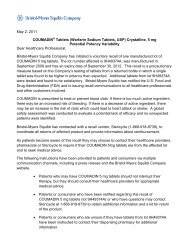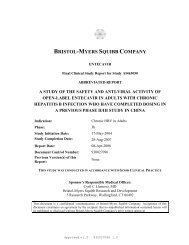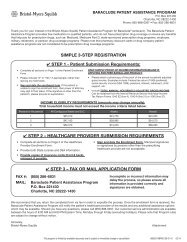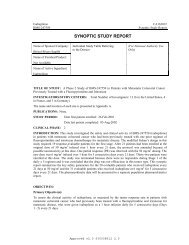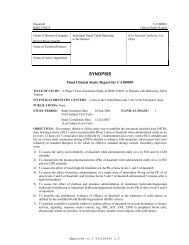BRISTOL-MYERS SQUIBB COMPANY - Clinical Trials
BRISTOL-MYERS SQUIBB COMPANY - Clinical Trials
BRISTOL-MYERS SQUIBB COMPANY - Clinical Trials
Create successful ePaper yourself
Turn your PDF publications into a flip-book with our unique Google optimized e-Paper software.
<strong>BRISTOL</strong>-<strong>MYERS</strong> <strong>SQUIBB</strong> <strong>COMPANY</strong><br />
CETUXIMAB<br />
Final <strong>Clinical</strong> Study Report for Study CA225315<br />
A Study to Evaluate the Relationship Between Cetuximab Therapy and<br />
Corrected QT (QTc) Interval Changes in Patients with Advanced<br />
Maligancies from Solid Tumors<br />
Indication:<br />
Phase:<br />
Study Initiation Date:<br />
Study Completion Date:<br />
Report Date:<br />
Oncology<br />
2A<br />
23-Feb-2009<br />
01-Feb-2010<br />
29-Jul-2010<br />
Document Control Number: 930044979<br />
THIS STUDY WAS CONDUCTED IN ACCORDANCE WITH GOOD CLINICAL PRACTICE<br />
Sponsor’s Responsible Medical Officer:<br />
Jaspreet Jaggi, MD, PhD<br />
Bristol-Myers Squibb<br />
Princeton, NJ 08536 USA<br />
This document is a confidential communication of Bristol-Myers Squibb Company. Acceptance of this<br />
document constitutes an agreement by the recipient that no unpublished information contained herein will<br />
be published or disclosed without Bristol-Myers Squibb Company's prior written approval.<br />
Approved v 1.0<br />
930044979 1.0
Cetuximab<br />
BMS-564717<br />
Name of Sponsor/Company:<br />
Eli Lilly and Bristol-Myers<br />
Squibb<br />
Name of Finished Product:<br />
Erbitux ®<br />
Name of Active Ingredient:<br />
Cetuximab<br />
Individual Study Table Referring<br />
to the Dossier<br />
CA225315<br />
Final <strong>Clinical</strong> Study Report<br />
(For National Authority Use<br />
Only)<br />
SYNOPSIS<br />
Final <strong>Clinical</strong> Study Report for Study CA225315<br />
TITLE OF STUDY: A Study to Evaluate the Relationship Between Cetuximab Therapy and Corrected<br />
QT (QTc) Interval Changes in Patients with Advanced Malignancies from Solid Tumors<br />
INVESTIGATORS/STUDY CENTERS: The study was conducted at 20 centers in the United States<br />
(US), with 16 of the centers enrolling at least 1 subject and 14 of the centers treating at least 1 subject.<br />
PUBLICATIONS: None<br />
STUDY PERIOD: Study Initiation Date: 23-Feb-2009 CLINICAL PHASE: 2A<br />
Study Completion Date: 01-Feb-2010<br />
OBJECTIVES:<br />
The primary objective was to assess the change in QT/QTc interval from time-matched baseline in the<br />
study population.<br />
The secondary objective was to assess the safety and tolerability of cetuximab administration in the study<br />
population.<br />
METHODOLOGY:<br />
This was a multicenter, non-randomized, single-arm, monotherapy study to determine the effect, degree of<br />
effect, or lack of effect of cetuximab on the QTc interval in subjects with advanced malignancies originated<br />
from solid tumors.<br />
The study consisted of a screening period for determination of study eligibility, a baseline<br />
electrocardiogram (ECG) period (Day -7 to Day -4), an on-treatment ECG period (Day 1 to completion of<br />
Day 29 ECGs), and an on-treatment post-ECG period (after completion of Day 29 ECGs to the off-study<br />
day). In addition, subjects who discontinued treatment at or prior to the Week 8 infusion of cetuximab were<br />
followed for toxicity during the post-treatment period.<br />
Eligible subjects who met all criteria for enrollment received weekly cetuximab infusions at an initial dose<br />
of 400 mg/m 2 intravenously (IV) on Day 1 (Week 1) followed by a maintenance dose of 250 mg/m 2 IV on<br />
Days 8, 15, 22, and 29 (Weeks 2 to 5) and Weeks 6 through 8. Premedication with diphenhydramine<br />
hydrochloride (HCl) 50 mg IV was administered prior to the first 5 infusions, and thereafter at the<br />
discretion of the investigator. Diphenhydramine HCl was also administered during collection of baseline<br />
ECGs on Days -7 to -4. During Weeks 6 to 8, subjects may have received additional therapies (e.g.,<br />
chemotherapy, radiation therapy), if medically indicated. Holter monitoring for collection of digital 12-lead<br />
ECGs and serum sampling for cetuximab concentrations were performed during the baseline ECG period<br />
Approved v 1.0<br />
930044979 1.0
Cetuximab<br />
BMS-564717<br />
CA225315<br />
Final <strong>Clinical</strong> Study Report<br />
and on Days 1, 8, 15, 22, and 29. Physical examinations, chest x-rays, clinical laboratory tests, and<br />
assessments of vital signs and Eastern Cooperative Oncology Group (ECOG) performance status were also<br />
performed at selected times during the study. Subjects were closely monitored for adverse events (AEs)<br />
throughout the study. At the end of Week 8, subjects were evaluated for disease progression according to<br />
institutional standard of care. Subjects with progressive disease were discontinued from cetuximab therapy,<br />
while subjects without progressive disease or intolerable toxicity were permitted to continue to receive<br />
cetuximab therapy via the post-study drug program.<br />
A complete treatment cycle consisted of 4 weeks of cetuximab therapy. The approximate duration of study<br />
participation for each subject who completed the study, from baseline through the last on-study day, was<br />
approximately 9 weeks.<br />
NUMBER OF SUBJECTS (Planned and Analyzed):<br />
Thirty-two (32) evaluable subjects were planned, 51 subjects were treated, and 37 subjects were considered<br />
evaluable for QT/QTc and were included in the ECG analyses.<br />
DIAGNOSIS AND MAIN CRITERIA FOR INCLUSION:<br />
Male and female subjects ≥ 18 years of age who had histologically or cytologically documented advanced<br />
or metastatic malignant disease of solid tumor origin that was considered measurable and/or evaluable, and<br />
who had adequately recovered from prior therapy or interventions, were eligible to participate in the study.<br />
Women of childbearing potential (WOCBP) were excluded from participation if they were nursing,<br />
pregnant, or unwilling or unable to use an acceptable method of contraception during the study and for a<br />
period of at least 12 weeks after the last on-study dose of cetuximab. All WOCBP were required to have a<br />
negative pregnancy test within 72 hours prior to administration of cetuximab on Day 1. Male subjects were<br />
excluded from study participation if they were unwilling to use an acceptable method of contraception<br />
during the study if having sexual relations with a female partner of childbearing potential.<br />
TEST PRODUCT, DOSE AND MODE OF ADMINISTRATION, DURATION OF TREATMENT,<br />
BATCH NUMBERS:<br />
All subjects received cetuximab at an initial dose of 400 mg/m 2 IV over 120 minutes followed by weekly<br />
maintenance dose of 250 mg/m 2 IV over 60 minutes for a total of up to 8 on-study infusions. Cetuximab<br />
for injection was supplied by Bristol-Myers Squibb (BMS) in 50-mL single-use vials containing 100 mg of<br />
cetuximab as a clear, colorless 2 mg/mL solution in phosphate buffered saline (Batch number 08C00190).<br />
The contents of the vial were administered without dilution.<br />
Prior to each IV infusion of cetuximab on Weeks 1 to 5, subjects received an IV infusion of<br />
diphenhydramine HCl 50 mg over 15 minutes. On the baseline day, subjects received an IV infusion of<br />
diphenhydramine HCl 50 mg over 15 minutes followed by 0.9% normal saline at 75 to 100 mL/hr.<br />
Diphenhydramine HCl was administered at the discretion of the investigator on Weeks 6 to 8.<br />
REFERENCE THERAPY, DOSE AND MODE OF ADMINISTRATION, DURATION OF<br />
TREATMENT, BATCH NUMBERS:<br />
No reference therapy was administered in this study.<br />
CRITERIA FOR EVALUATION:<br />
Safety: The primary ECG endpoint was the time-matched mean change from baseline (designated as “∆”)<br />
in QTc at each ECG sampling timepoint. Cetuximab concentration-to-QTc relationship was also evaluated.<br />
Similar endpoints were evaluated for PR interval, QRS interval, and ECG-derived heart rate (HR). The<br />
general safety assessment was based on medical review of reported AEs and the results of vital sign<br />
measurements, physical examinations, and clinical laboratory tests. The incidence of observed AEs was<br />
tabulated and reviewed for potential significance and clinical importance.<br />
Approved v 1.0<br />
930044979 1.0
Cetuximab<br />
BMS-564717<br />
CA225315<br />
Final <strong>Clinical</strong> Study Report<br />
Pharmacokinetics: Serum cetuximab concentrations were measured at pre-dose and each ECG timepoint<br />
during/after infusion of cetuximab to permit a concentration-response analysis. Cetuximab pharmacokinetic<br />
(PK) parameters were not estimated in this study.<br />
STATISTICAL CONSIDERATIONS:<br />
Sample Size Determination: This was a single-arm estimation trial; the sample size was not based on<br />
statistical power calculation. At each ECG sampling timepoint, the time-matched mean ∆QTc was<br />
estimated, and a one-sided upper 95% confidence limit was constructed for the population means of ∆QTc<br />
based on the assumption that ∆QTc was normally distributed with a standard deviation of 20 msec. The<br />
20 msec standard deviation was chosen based on data from single-arm Phase 2 oncology trials previously<br />
conducted by BMS. Per protocol, the study remained open to enrollment until 32 evaluable subjects had<br />
completed the required study assessments. If the estimated population mean for ∆QTc was 4 msec at a<br />
given ECG sampling timepoint, then 32 subjects would have a one-sided upper 95% confidence limit<br />
(-∞, 9.815). If the estimated population mean for ∆QTc was 0 msec at a given ECG sampling timepoint,<br />
then 32 evaluable subjects would have a one-sided upper 95% confidence limit (-∞, 5.815).<br />
Statistical Analysis:<br />
Safety: Adverse events and laboratory tests were summarized for all treated subjects.<br />
All treated subjects who met all inclusion criteria and none of the exclusion criteria, and who were not<br />
considered unevaluable based on any of the protocol-specified criteria were included in the ECG analysis<br />
described below. Fridericia’s correction formula was used to calculate the heart rate-corrected QT interval<br />
(QTcF). For each ECG parameter (QT, QTc, RR, QRS, PR, and HR), the mean of the triplicate<br />
measurements at each timepoint was considered for all analyses. ECG measurements collected on the<br />
baseline day were used to compute time-matched change from baseline for each ECG parameter. Individual<br />
ECG parameter measurements and corresponding changes from baseline were listed, and values outside a<br />
normal range were flagged. ECG abnormalities identified by the ECG core laboratory were listed.<br />
QTc Analysis of Central Tendency: The effect of cetuximab on the QTc interval was assessed by summary<br />
statistics (n, mean, standard error, minimum, and maximum) for QTc and time-matched ∆QTc, and<br />
examination of plots of mean (+ one-sided upper 95% confidence limit) QTc and time-matched ∆QTc<br />
versus time since dosing. At each ECG sampling timepoint, the mean time-matched ∆QTc was estimated<br />
and a one-sided upper 95% confidence limit was constructed for the population means of ∆QTc at the<br />
timepoint.<br />
QTc Categorical Analysis: The effect of cetuximab on QTc interval was also assessed by frequency<br />
distributions (n, percentage) for subjects meeting or exceeding predefined values for maximum QTc (≤<br />
450 msec, > 450-480 msec, > 480-500 msec, > 500 msec) and maximum time-matched ∆QTc (≤ 30 msec,<br />
> 30-60 msec, > 60 msec).<br />
QTc Concentration-Response Analysis: Cetuximab concentration-QTc response was explored graphically<br />
using double y-axis plots of mean time-matched ∆QTc and mean drug concentration versus time since<br />
dosing and scatter plots of individual subjects’ QTc and time-matched ∆QTc values versus the nearest<br />
corresponding serum drug concentrations. For the plot of time-matched ∆QTc versus drug concentrations,<br />
the estimated linear regression, taken from the results of fitting a random intercept and slope model with<br />
cetuximab concentration as the only covariate to the data, was included in the plot.<br />
QRS, PR, HR analyses: The effect of cetuximab on QRS and PR intervals and HR was assessed by<br />
summary statistics for reported values and the corresponding time-matched changes from baseline, and<br />
examination of plots of mean (+ standard error) reported values and time-matched mean changes from<br />
baseline versus time since dosing. Cetuximab concentration-response was explored graphically as<br />
described above for QTc, but regression analysis was not performed.<br />
Pharmacokinetics: Cetuximab concentrations were listed. No PK data analysis was planned or conducted.<br />
Approved v 1.0<br />
930044979 1.0
Cetuximab<br />
BMS-564717<br />
CA225315<br />
Final <strong>Clinical</strong> Study Report<br />
SUMMARY OF RESULTS:<br />
Disposition and Baseline/Demographic Characteristics:<br />
Fifty-one (51) of the 79 enrolled subjects received at least 1 infusion of cetuximab in the study. The<br />
disposition of these treated subjects is summarized in Table 1. Demographic and pretreatment<br />
characteristics of treated subjects are summarized in Table 2.<br />
Table 1:<br />
Subject Disposition<br />
Overall<br />
No. of Subjects Enrolled 79<br />
No. of Subjects Treated 51<br />
No. of Subjects Excluded from ECG Analysis 14<br />
No. of Subjects Discontinued a 18<br />
Disease progression 7<br />
AE unrelated to study drug 3<br />
Study drug toxicity 2<br />
Withdrawal of consent 2<br />
Failure to meet criteria for continuing treatment 2<br />
Other 2<br />
a Includes subjects discontinuing prior to Week 8.<br />
Table 2:<br />
Characteristics<br />
Age, years<br />
Mean (SD)<br />
Range<br />
Gender, n (%)<br />
Male<br />
Female<br />
Race, n (%)<br />
White<br />
Black<br />
Asian<br />
Other<br />
ECOG Status, n (%)<br />
0<br />
1<br />
2<br />
Demographic and Pretreatment Characteristics<br />
Treated Subjects<br />
(N=51)<br />
61 (12)<br />
38, 84<br />
30 (59)<br />
21 (41)<br />
45 (88)<br />
1 (2)<br />
4 (8)<br />
1 (2)<br />
16 (31)<br />
30 (59)<br />
5 (10)<br />
Approved v 1.0<br />
930044979 1.0
Cetuximab<br />
BMS-564717<br />
CA225315<br />
Final <strong>Clinical</strong> Study Report<br />
Safety Results:<br />
Lack of effect on QTc interval was demonstrated at the approved dose and dosing schedule of cetuximab.<br />
The one-sided upper 95% confidence limit for the time-matched mean ∆QTcF was < 10 msec at all<br />
timepoints (Figure 1).<br />
Figure 1:<br />
Time-matched Mean (+95% CI) ∆QTcF Versus Time Since Dosing on Each<br />
Study Day - All QTc Evaluable Subjects<br />
There were no QTcF values > 500 msec and no time-matched ∆QTcF values ≥ 60 msec. One subject with a<br />
history of hypertension and evidence of prior inferior myocardial infarction on baseline ECGs had mean<br />
QTcF interval readings ≥ 480 msec and ≤ 500 msec at 2 timepoints on Day 22 (481 msec and 483 msec at 1<br />
hour and 2 hours, respectively). Thirteen (13) subjects had a maximum time-matched ∆QTcF > 30 msec<br />
and ≤ 60 msec at one or more timepoints during the study. There did not appear to be any trends over time<br />
in the incidence of these outliers.<br />
No concentration-related trends were apparent in QTcF or ∆QTcF based on examination of scatter plots of<br />
QTcF and time-matched ∆QTcF (Figure 2) versus serum cetuximab concentration for each study day, and a<br />
double y-axis plot of time-matched mean ∆QTcF and mean cetuximab concentration versus time since<br />
dosing. Regression analysis on scatter plots for ∆QTcF yielded point estimates for the slope of the<br />
regression line ranging from -0.018 to +0.026 msec per ng/mL with two-sided 90% confidence intervals<br />
encompassing zero.<br />
Approved v 1.0<br />
930044979 1.0
Cetuximab<br />
BMS-564717<br />
Figure 2:<br />
CA225315<br />
Final <strong>Clinical</strong> Study Report<br />
Scatter Plots of Time-matched ∆QTcF Versus Cetuximab Concentration on<br />
Each Study Day - All QTc Evaluable Subjects<br />
Cetuximab had no effect on PR interval, QRS interval, or HR based on examination of summary statistics<br />
for each parameter and corresponding time-matched changes from baseline, as well as plots of mean values<br />
and time-matched mean values versus time since dosing. Eight (8) subjects had PR interval measurements<br />
> 200 msec on-study, each of whom also had baseline PR interval measurements > 200 msec. No subject<br />
had a QRS interval measurement > 120 msec during the study. Fifteen (15) subjects had a HR measurement<br />
> 100 bpm at baseline and/or on-study. There did not appear to be any trends over time in the incidence of<br />
these outliers. No concentration-related trends were apparent in PR, QRS, or HR based on examination of<br />
scatter plots of reported values and corresponding time-matched changes from baseline versus cetuximab<br />
concentration. The most frequently reported ECG conduction abnormality was a non-specific<br />
intraventricular conduction defect, and the most frequently reported ECG rhythm abnormality was sinus<br />
tachycardia. Overall, 22 subjects had 1 or more abnormal ECGs that the consulting cardiologist assessed as<br />
potentially clinically significant. Ten (10) of these subjects had abnormal ECGs of potential clinical<br />
significance at screening or baseline only. In the other 12 subjects, abnormalities of potential clinical<br />
significance were generally reported both prior to and after initiation of cetuximab treatment. These<br />
abnormalities included but were not limited to evidence of MI and/or conduction defects such as inverted T<br />
waves, ST depression, and first degree atrioventricular (AV) block. One ECG-related AE (anterolateral<br />
myocardial infarction) was reported by the investigator, and was assessed as unrelated to treatment with<br />
cetuximab.<br />
Table 3 provides an overview of safety for treated subjects. Forty-nine (49) subjects reported at least 1 AE<br />
while on study. These on-study AEs were consistent with the known safety profile for cetuximab, and most<br />
frequently included rash, headache, dermatitis acneiform, and nausea. The majority of on-study AEs were<br />
assessed by the investigator as Grade 1 or Grade 2.<br />
No cetuximab-related deaths were reported. Six (6) subjects died on-study due to complications related to<br />
underlying disease. An additional 10 subjects reported 1 or more non-fatal serious adverse events (SAEs).<br />
SAEs in 8 subjects were assessed as unrelated to cetuximab, including the one Grade 4 event reported<br />
during the study (pain). Two (2) subjects experienced serious infusion reactions during administration of<br />
Approved v 1.0<br />
930044979 1.0
Cetuximab<br />
BMS-564717<br />
CA225315<br />
Final <strong>Clinical</strong> Study Report<br />
the first infusion of cetuximab. These reactions were reported by the investigator as treatment-related<br />
Grade 3 SAEs of infusion-related reaction in 1 subject and bronchospasm and dyspnoea in the other<br />
subject, and resulted in discontinuation of cetuximab therapy. One (1) other subject discontinued therapy<br />
due to disease progression coincident with treatment-related AEs that were reported as leading to<br />
discontinuation of therapy (nausea, blisters, vomiting, and pustular rash). An additional 7 subjects<br />
discontinued therapy due to AEs that were considered unrelated to cetuximab.<br />
Table 3:<br />
Summary of Safety - Treated Subjects<br />
Number of Subjects (%)<br />
Any Event<br />
Treatment-Related Event<br />
Deaths 6 (11.8) 0<br />
SAEs 16 (31.4) 2 (3.9)<br />
AEs leading to discontinuation 10 (19.6) 3 (5.9) a<br />
Common AEs<br />
Rash 22 (43.1) 21 (41.2)<br />
Headache 12 (23.5) 3 (5.9)<br />
Dermatitis acneiform 9 (17.6) 9 (17.6)<br />
Nausea 6 (11.8) 2 (3.9)<br />
a One (1) subject discontinued therapy due to disease progression coincident with the development of AEs<br />
reported by the investigator as leading to discontinuation of cetuximab treatment.<br />
Adverse events of special interest for cetuximab were evaluated in this study under the composite<br />
categories of acneform rash, infusion reactions, and cardiac events. Acneform rash and infusion reactions<br />
were reported (any grade) for 62.7% and 11.8% of treated subjects, respectively, and all of these events<br />
were treatment-related with the exception of a single event of rash. Cardiac events were reported for<br />
2 subjects (myocardial infarction and acute coronary syndrome, respectively) and were not considered<br />
treatment-related or associated with unusual or clinically-important ECG findings.<br />
The majority of laboratory values were Grade 0, 1, or 2, and only 1 Grade 4 abnormality<br />
(hypomagnesemia) was reported during the on-study period. Review of laboratory data from this study do<br />
not reveal any new safety concerns for cetuximab.<br />
Pharmacokinetic Results: All subjects had quantifiable cetuximab concentrations at each ECG timepoint<br />
after the initial infusion of cetuximab, with the exception of 1 subject with a non-quantifiable pre-dose level<br />
on Week 4 and 1 subject with non-quantifiable levels at 2 hours and 3 hours on Week 1. CONCLUSIONS:<br />
• Cetuximab treatment had no clinically-meaningful effect on QTc interval in humans at the<br />
recommended dose.<br />
• There was no apparent concentration-dependent effect of cetuximab on QTc interval.<br />
• No effect of cetuximab treatment was apparent on PR interval, QRS interval, or HR, and no<br />
concentration-response relationship was observed for any of these ECG parameters.<br />
• Safety observations in subjects treated with cetuximab in this study were consistent with the<br />
known safety profile for cetuximab.<br />
DATE OF REPORT: 29-Jul-2010<br />
Approved v 1.0<br />
930044979 1.0




